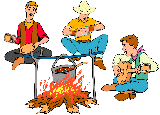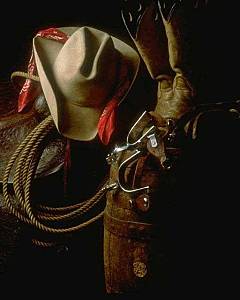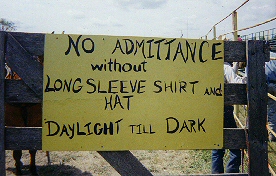
Cowboy Bob's Campfire Conversations
Table of Contents
Cowboy Bob and
the Bouncin' Bovine
The Philmont
Mountain Lion
The Dyin' Gunfighter
The Truth About
Wild Horses
Bunc Bradshaw
and the Mexican Captain
Cowboy Bob:
Movie Star
Some Other
Cowboy Paraphernalia
The First Bulldogger
God's Bit and
Bridle
The Adventures
of Cheyenne Dawson
Louis Remme's
Wild Ride
Cowboy Bob and the Bunny Buckle
Mountaintop Experiences
The Real Transcontinental Railroad
The Cowboy's Wardrobe
I was in a grocery store the other day, wearin' my usual duds: Stetson, jeans, western shirt, cowboy boots, a wide belt with a big buckle. Over it all was my trail-worn duster.
As I meandered down one aisle, I overheard a wide-eyed youngster whisperin' to his mother:
"Mom, he's a cowboy! I can tell!"
Nosiree, There's no mistakin' a cowboy when you see him.
Did you ever wonder why cowboys dress the way they do?
Some folks assume that it's all just for looks, but just about
everythin' a cowhand puts on his carcass has a reason for bein' the way
it is.

Take, for example his hat:
A cowboy will usually put up with a lot of horseplay and practical jokes -- but don't ever mess with his hat!
In addition to bein' the second most costly item in his wardrobe (boots are the most expensive), the hat is arguably the most essential for his survival. A blanket or a hide can replace clothes, and Indians have run around barefoot for centuries, but the hat gives protection against heat and cold, wind, rain, sun, branches, and a multitude of other tribulations.
At night, the hat is a cowpoke's roof, keepin' the elements off the only part of the anatomy that sticks out of his bedroll. Some folks say his hat is the first thing a cowboy puts on in the mornin'. Most likely, he never took it off. When the sun is low on the horizon, the distinctive vee-shaped brim in front blocks out the sun, while allowin' him to see on both sides of ol' Sol. (Try it sometime when you're drivin' right into the sun - it works much better than any other sun visor!)
The high crown -- the feature that gave the "ten-gallon" hat its name -- provides insulation and ventilation. It's a kinda "soft hard hat," cushionin' against blows from low-hangin' branches or the whip-like stings of a critter's tail. It can be used for carryin' water or oats, gatherin' nuts or berries, or takin' up an offerin'. There's nothin' better for fannin' a campfire or swattin' flies off your horse.
The second most crucial part of a cow-poke's duds would be his boots.
Some folks can't imagine why a cowboy would pay most of a month's wages for a pair of boots. Just think of it as insurance.
Most cowboy boots are made of rugged, but supple, leather and range in height from mid-calf to just below the knee. That's to save the leg from the wear and tear of the stirrup leathers as well as protectin' from rattlesnakes and other assorted ankle-biters.
The pointy toes help a rider catch the stirrups easier. The high heel prevents his foot from accidentally slippin' into -- and gettin' caught in -- the stirrup. The thin, smooth soles give him a better feel for the stirrups and make it easy to slip his feet into the right position.
 Over the years, I've seen lots of cowboys -- in person and in pictures. In all that time, the only ones I've seen wearin' short sleeves were at a picnic. Even in the hottest territory, no savvy cowhand would give up long sleeves. They protect against brush, dirt, scrapes and cuts. As for sun protection, long sleeves block ultra-violet and every other kind of light. Get them wet with sweat, and they do a fair job of coolin', too. (At the North Star Stampede Rodeo, you can't even get into the arena with short sleeves, as witnessed by the photo on the right.)
Over the years, I've seen lots of cowboys -- in person and in pictures. In all that time, the only ones I've seen wearin' short sleeves were at a picnic. Even in the hottest territory, no savvy cowhand would give up long sleeves. They protect against brush, dirt, scrapes and cuts. As for sun protection, long sleeves block ultra-violet and every other kind of light. Get them wet with sweat, and they do a fair job of coolin', too. (At the North Star Stampede Rodeo, you can't even get into the arena with short sleeves, as witnessed by the photo on the right.)
One of the features that defines a western shirt is the use of snaps instead of buttons. The reason is pretty obvious. While your left hand is busy with the horse's reins, try unbuttonin' a shirt to scratch an itch or to stash somethin' inside your shirt. Then, try buttonin' it up again -- still usin' only one hand.
With snaps, the job is, well, a snap.
The other unique feature of the western shirt is the use of a triangular style on the shoulder yokes and pocket flaps.
Any schoolmarm will tell you that a triangle is strongest shape in geometry. That's why bridges are usually packed full of triangles. The parts of a cowboy's shirt that take the most strain are-you guessed it-the yoke and pocket flaps.
Why, you ask, does a cowboy need flaps and snaps on his shirt pockets? Try this little expeery-ment: put a hoof-pick or a little brand book in your flapless shirt pocket. Next, bend way over to lift your horse's hoof. If that don't convince you, saddle up and kick your mount into a nice bouncy trot or lope.
What self-respectin' cowboy would be caught dead in any pants but blue jeans? Well, to tell the truth, a lot of them never even saw a pair.
In the old days, most cowboys didn't have enough money to buy new clothes at the tailor's, so they bought ready-to-wear: second-hand duds that the wealthy folks didn't want anymore. That's why a cowhand of the 1840s or 50s was likely to arrive at the roundup wearin' an old broadcloth suit. After the Civil War, many veterans wore their old uniform pants.
Jeans were named for the Italian town of Genoa, called "Genes" by French tailors. The weavers in Genoa, or Genes, were famous for a sturdy, twilled cotton cloth, much like denim.
Back in the 1850s, a seventeen-year-old tailor named Levi Strauss emigrated to San Francisco, where he started stitchin' up canvas britches for the gold miners. (Leave it to a teen-ager to invent blue jeans.) A few years later, he switched from stiff canvas to more comfortable denim.
Why are jeans blue? Originally, jeans were the natural canvas or denim color -- which showed dirt, grass, and other stains very quickly. Sometime in the 1860s, Strauss discovered that dyin' the pants a deep indigo reduced soilin' -- and increased sales.
In order to achieve a snugger fit -- and reduce the chance of the pants snaggin' on the saddle, or otherwise gettin' in the way -- cowboys would put a new pair of jeans on, get them soakin' wet, and let them shrink to a custom fit as they dried.
One topic of debate around many bunk houses is whether to tuck jeans into the boots, or leave them outside. The answer is that there ain't no right or wrong way; you wear 'em whichever way you want to. If you tuck them in, you protect your jeans a bit, and may make it harder for them creepy-crawlies to slither up your legs.
Me, I wear 'em on the outside, 'cause it keeps rain and dirt from gettin' into my boots. Also, I don't like all that denim bunched up around my legs.
Give me a minute or two to fill my coffee cup, and I'll be back to tell you about some other parts of the cowboy's get-up.
![]() Return
to Table of Contents
Return
to Table of Contents
![]() Return to Cowboy Bob's Home Page
Return to Cowboy Bob's Home Page
COPYRIGHT © 1999 BOB LEMEN, GRAND RAPIDS,
MINNESOTA. ALL RIGHTS RESERVED.
Westernwear photo © Nova Development - used under license.